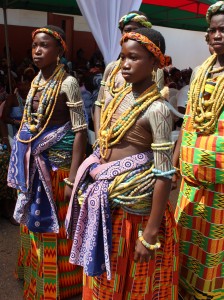Krobo Pearls – Dipo rites and its role in the society
 The Dipo rite is an integral part of the Krobo culture. Over the years it has been used to inculcate useful values into adolescent girls as they prepare to assume their marital responsibilities.
The Dipo rite is an integral part of the Krobo culture. Over the years it has been used to inculcate useful values into adolescent girls as they prepare to assume their marital responsibilities.The Krobos are part of the Ga-Dangbe ethno linguistic group and they are the largest group of the seven Dangbe ethnic groups of South-Eastern Ghana.
The ancestral home of the Krobos has been linked to the Upper Niger or Kwara River area of Nigeria. These groups of people are traditionally known as “Same” or “Saberma”.
My grandfather says the word Krobo is derived from the word “AKRO” and the Akans on encountering them called them “Kro Obo So Fo” which means mountain dwellers.
The region is known for the ‘Krobo Pearls’ these are distinctive rocks used in the beads industry and are nicknamed as such and adorned on the Dipo initiates.
Well, one can as well say Dipo is the process through which a young girl graduates to womanhood or motherhood and is fully integrated within her society.
Dipo is not unique to the Krobos alone but it is celebrated by the people of Manya and Yilo Krobo, in Krobo
Odumase and Somanya in the Eastern Region. And in these areas as well, Dipo rites are performed annually in April and by participating in the process, adolescent girls are readied for marital roles.
Parents upon hearing the Dipo initiation dates send their adolescent girls to the chief priest under whose tutelage the girls would have to go through various tests and rituals to prove that they are qualified for the Dipo rites.
The qualified initiates are then adorned with a bead-necklace and strand of leaves. Little cuts are also made on the arms and one by one they lift up a small grinding stone and placed it on larger stone.
Their introduction to the grinding stone marks the beginning of the Dipo rite. They are kept for a while till they are sent to another part of the mountain “Tegbe te” or “Tegbe rock” and given a Dipo- headwear, a tall straw hat.
The entire duration of the Dipo process is about a weeks training in housewifery and childcare activities and initiates above the age twenty-one are those who participate in this process.
Prior to their departure to the Tegbe rock, a sheep is provided by the parent of an initiate. The animal is then slaughtered and disemboweled, the innards cleaned and inflated.
The inflated parts are then wrapped around the shoulders of the girls before they are conducted to the Tegbe rock. Each initiate is made to sit for a while on the Tegbe rock and stand. This is repeated three times and with this, the rite performance is over for the initiate.
The girls are then led to their homes amidst great rejoicing, gun firing and songs. This is a great joy because it also means that the girls have maintained their chastity and can now begin the womanhood stage of their lives.
Maa Dam, a fetish priestess from Kpogunor, a suburb of Odumase, in an interview with the Ghana News Agency, said in times past, the circumcision of a male child among Krobos was what called for a celebration and merry making.
This is because it signifies that the child will grow to become real man in the community and any male child who wasn’t circumcised was regarded an outcast. In order to do something similar for girls, the celebration of Dipo was introduced.
Maa Dam said any Krobo girl who does not participate in the Dipo rites before becoming pregnant is considered an outcast in the society.
Maa Salomey Tetteh, another elder in the Dipo process, said the rite is important in the life of every Krobo girl.
She said there is the need to highlight the essential housewifely roles the initiates undergo during the period and these include sweeping, cooking and washing amongst others. They are taught how to bath, relate with people especially their husbands.
She said in these times, the purpose of the rites is also help prevent teenage pregnancies, creating awareness on the dangers of premarital sex and also to train the young women to become capable mothers in the society.
By Elizabeth Baah
Source: GNA

This is beautiful and very educative